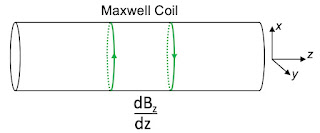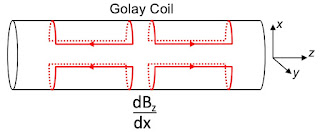The Maxwell coil is great for producing the magnetic field gradient dBz/dz needed for slice selection in MRI, but what coil is required to produce the gradients dBz/dx and dBz/dy needed during MRI readout and phase encoding? That, my friends, is a story for another post.Today, I will finish the story.
First, let’s assume the gradient coils are all located on the surface of a cylinder. If this were a clinical MRI scanner, the person would lie on a bed that would be slid into the cylinder to get an image. The Maxwell coil consists of two circular coils, separated by a distance equal to the square root of three times the coil radius. The parts of the coil in the back that are hidden by the cylinder are shown as dashed. The two coils carry current in opposite directions, as shown below, creating a gradient dBz/dz in the imaging region midway between the two coils on the axis of the cylinder.
To perform imaging, however, you need gradients in the x and y directions too. To create dBz/dx, you typically use what is called a Golay coil. It consists of four coils wound on the cylinder surface as shown below.
The mathematics to determine the details of this design is too complicated for this post. Suffice to so, it requires setting the third derivative of Bz with respect to x equal to zero. The resulting coils should each subtend an angle of 120°. Their inner loops should be separated by 0.778 cylinder radii, and their outer loops by 5.14 radii.
To create the gradient dBz/dy, simply rotate the Golay coil by 90°, as shown below.
So, to perform magnetic resonance imaging you need a nested set of three coils as shown below.
The picture gets confusing with all the hidden lines. Here is how the set looks with the hidden parts of the coils truly hidden.
While this set of coils will produce linear magnetic field gradients in the central region, in state-of-the-art MRI scanners the coils are somewhat more complicated, with multiple loops corresponding to each loop shown above.
We all know who Helmholtz and Maxwell are, but who is Golay? Marcel J. E. Golay (1902-1989) was a Swiss scientist who came to the US to get his PhD at the University of Chicago and then stayed. He had a varied career, making fundamental advances in chromatography, information theory, and the detection of infrared light. He studied the process of shimming: making small adjustments to the magnetic field of a MRI scanner to make the static field more homogeneous. This work ultimately led to the design of gradient coils.
In Chapter 18 of Intermediate Physics for Medicine and Biology, Russ Hobbie and I discuss magnetic resonance imaging and the need for magnetic field gradients. In a nutshell, MRI converts magnetic field strength to spin precession frequency. By measuring this frequency, you can obtain information about magnetic field strength. A magnetic field gradient lets you map frequency to position, an idea which is at the heart of imaging using magnetic resonance.








No comments:
Post a Comment